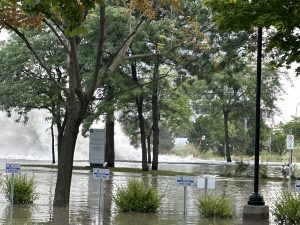Although drones are not new in Canada, there is little hard information on the unmanned aerial vehicles (UAVs) and how they could be used in construction, said Pierre Boucher, president of Canadian Construction Innovations (CCInnovations) in Ottawa.
"Drones have not yet been commercialized in many sectors, including construction," he said.
"Little, apart from anecdotes, is known about how they are being used in construction."
To increase the amount of information on drones — also known as unmanned aerial systems (UASs) — and how they can be used, CCInnovations is preparing an information booklet.
Believed to be the first document of its kind in Canada, the booklet is slated to be released in October.
Boucher said the brochure will be between 25 and 30 pages long and contain both text and graphics.
"It will have a lot of information on drones in one package," he said.
The booklet will address the size of drones and their differences in cost and capabilities, as well as peripheral equipment, such as 3D modeling, sensors and transmission capabilities.
It will also contain information on specific applications of drones in the construction industry, legal requirements regarding the use and operation of drones, risks associated with the use of drones and insurance coverage.
"We’re working on the booklet right now," Boucher said. "And, we’ve already moved on to the next stage, which is a collection of case studies on how drones are being used in construction in Canada."
The purpose of the booklet, in addition to being a collection of useful information, is to encourage the use of drones in construction.
"There are efficiencies and cost savings to take advantage of," Boucher said.
"We’re looking to the future."
While little is known about the use of drones in Canadian construction, UAVs are already being used in the U.S., Australia and the U.K., said Ken Lancastle, associate director of industry practice with the Canadian Construction Association (CCA).
"Their use will only grow in the future," he said. "In fact, the sky is the limit."
According to the CCA, there are a number of possible uses for drones on Canadian construction sites.
For example, UAVs can be used for aerial surveillance. Drones can help calculate site dimensions, height restrictions and access points.
Aerial imagery can be measured against drawings and models.
Drones can also be used for jobsite surveillance, providing live feedback for site superintendents and safety officers.
Another use is high-definition (HD) video. Drones carrying HD video cameras can show the progress on a construction site at much lower cost than airplanes or helicopters.
In January 2015, DIALOG Design in Edmonton and the Calgary office of aerial services provider Skymatics made the first legal drone flight over downtown Edmonton when they flew a UAV over the construction sites of Rogers Place Arena and the Walterdale Bridge.
The purpose of the 15-minute flight was to produce a video document of the progress on the projects, on which his company is a consultant, said DIALOG practice principal Jeff DiBattista.
"In the future, we plan to use drones as standard company operating procedure," he said. "The construction industry needs to embrace new technologies, such as drones. The technology has improved so much and the cost has come down to the point where it is only a small investment for us."
DIALOG and Skymatics flew over the Edmonton sites in May and again in mid-September and plan two or three more flights.
Drones are not without their challenges, especially in the form of Transport Canada (TC) regulations.
Operators of drones that are either less than 2 kgs in weight or between 2.1 kgs and 25 kgs can apply for a TC permission exemption, which can take 10 to 30 days to receive.
Aspiring operators that are not eligible for an exemption will have to apply for a Special Flight Operations Certificate, which can be used for one location on one day.
Kris Harris, co-founder of Beacon Media Group Inc. in Ottawa and Whistler, said operators will need at least $100,000 in liability insurance.
"You will also need to have one drone operator and one on-the-ground supervisor," he said.
"You can fly up to 400 vertical feet, but you must stay in line of sight and you can’t fly over operating roads."











Recent Comments
comments for this post are closed